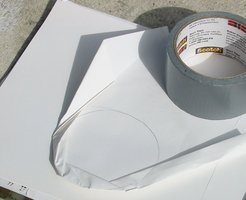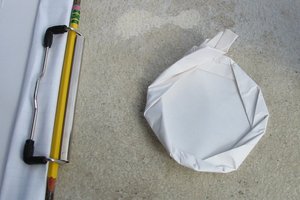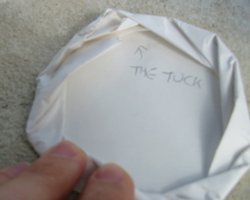


Fair warning: this is an incomplete report. I wrote some things. And then I went and played in Shinteki Decathlon II and wrote about that. And then I sat down to write more about this, the Google Intern Scavenger Hunt, and I'd forgotten most of the cool anecdotes.
It was the morning of July 12, 2006, and I was at San Francisco's Aquatic Park. Soon, hundreds of Google engineering inters would be here for a scavenger hunt. We'd "outsourced" the game creation to Just Passing Through, a.k.a. the Shinteki people. So I wasn't so surprised when I didn't see any Google interns--they were probably still being bused up from company HQ--but instead found Brent and Linda Holman sitting on a bench. We chatted a little. But then I wandered off for a quick experiment.
You may recall that at the start of my first-ever grown-up puzzle hunt game, the starting order was determined by a paper airplane toss at the Aquatic Park bleachers. Each team was given a piece of paper and a paperclip from which to assemble a paper airplane. There was strong wind. Each team would toss an airplane from the top of the bleachers; teams whose planes went furthest would start first. Our team had a few ideas which looked like they would get blown around by the wind too much. We were ready to default to the origami rock. Then I'd thought about frisbees. If you know what you're doing, you can toss a frisbee against the wind. I quickly tried to fold a piece of paper so that it had a heavy rim. The deadline neared. There was no time to try to perfect a paper frisbee, so we tossed the origami rock. (The winning plane was a mitre glider. I didn't know they did so well in the wind, but that one certainly did.)
This morning, I was ready to find out "What if." What if we'd had time to develop a paper frisbee? Would it have done well? I got out a roll of duct tape. (Not to put anything together, just as a circle guide.) I folded up a piece of paper into a circle. I tossed it around a little. It was a terrible frisbee. I hadn't balanced it well. It wobbled as it flew, when it wobbled it caught the wind, when it caught the wind, it was blown backwards. I tried cutting away some paper from the heaviest part--same problem.
So, in hindsight, it was a good thing we'd stuck with the origami rock.
While I was tossing that frisbee around the bleachers, Brent came over to talk. He said, "You understand, you can't try to solve these puzzles right? They're not--you'll just destroy them." Hmm, did Brent remember how I'd carefully captained a team into last place in a Shinteki game? Still, he was Game Control. You have to respect Game Control. "Ok, sure thing." Brent did throw me a bone, though: "Every team needs to take photos of the locations they're supposed to find. Usually one member of the team is photographer, so only N-1 people end up in the photo. If you take photos, then that team could have N people." OK, so I would be taking it easy for this game.
But it turns out that keeping quiet isn't so easy. At one point, I was looking at my team's partial solution. They'd made one little mistake in an early stage of the puzzle, but they were mostly on the right track. They'd figured out something like "LEADACTOYFEBRUARYSECONDKOVIC". Now I looked at that and saw a minorly garbled but basically clear message. But the interns I was with--they saw the "February second" part OK, but they weren't ungarbling the rest. They were going back, trying to fix their mistakes in the first stage of the puzzle. These kids weren't dumb--that's not what I'm trying to say. These kids were smart. I'm pretty sure that at least half of them had more raw intelligence than I did. I'm trying to say that it was pretty tough to keep my mouth shut.
To keep from blurting anything out, I bit down on the fleshy part of my hand. That worked. A few minutes later, the team was yelling, "Bill Murray! Bill Murray!" I extracted my hand from my mouth.
Later on in the day, the team was looking at another puzzle: a 2x3 array of pictures of faces. You know, a 2x3 array like the arrangement of dots within a Braille letter. They looked at that 2x3 array and started talking about 5-bit binary, with the "leftover" picture perhaps acting as a parity bit. I went around a corner, out of earshot, took some deep breaths.
At the wrap-up after the game, Brent asked how it had gone. "I think everybody had a great time," I said. "But you know, it was really hard to keep quiet about the puzzles." I showed off my hand bruise. Brent said, "Yeah, when we're playtesting, we watch people try to solve these puzzles. And you just want to say something..."
So if I ever administer a game playtest, I should remember to not drink so much coffee beforehand, to just stay cool and calm. And maybe wear a glove.
There was a first batch of puzzles. Each puzzle solved to a phrase. Entering the phrase into an app on a Palm Pilot. (The app was named LEON.) The pilot then told the team a location they could go to take a photo. These photos were worth points. If a puzzle wasn't making sense, the team could buy hints--but hints cost points. There were also bonus points available for photos that weren't related to any puzzles--such as a photo of the team in a tree, or dipping toes in the bay.
To solve the first batch of puzzles, the team headed across the street to Ghirardelli Square, where there was an alcove out of the wind. And there was a vital restroom. At one point, we even found out how many team members we could fit inside of that restroom. (All of them.)
The first batch of puzzles had a pretty one based on Google logos; a set of pyramids that had to be attached together to form a three-dimensional structure; and a mysterious set of numbers.
It took a while for the team to get into the rhythm of solving. People with puzzles weren't handking them around; people without puzzles sat idle. The instructions for participants had told them not to bother to bring pencils, making it sound as if they weren't so useful. Pencils had been available at the start of the hunt, but they hadn't sounded so useful. Now that we were looking at the puzzles, pencils seemed useful, but nobody had them. Well, I did, and I handed them around. OK, I interfered with team solving there. So sue me.
But those kids did hit their stride, and soon clusters of people were huddled over puzzles, winkling them out. And soon one of the puzzles was solved.
We were sitting around on a cluster of benches on a wharf, sheltered from the wind. The interns were looking at a page full of numbers. They'd tried a bunch of things, none of which worked. So they bought a hint. As holder of the Palm, I read the hint to them: each number on the sheet was the result of an arithmatic transformation. Now they would need to reverse that--the results would result in letters. (The instructions were a lot more specific than that. Suffice it to say, there was math involved.)
OK, so there were numbers to crunch. One or two of them had phones that were also calculators--frustratingly awkward calculators. I pointed out, "Hey, the Palm has a calculator" and handed it over. Soon the team was working well. They used a MapReduce-like workflow to parallelize the problem. One player apportioned numbers to people with calculators. People with calculators worked in parallel, each of them Mapping numbers into to letters. Each of them gave these letters to a single intern who carried out the Reduce step, placing letters next to the numbers which had generated them. Soon a message emerged. Ah, bliss.
On Pier 39, we got a new batch of puzzles. One of these was a two-by-three array of faces. Experienced puzzle-hunters look at it and say, "Braille". As I heard these kids talk about five-bit binary with an extra parity bit, I had to take a little walk around the corner, out of earshot, to whisper "it's Braille, dammit." But they were bright kids, and did figure it out.
Probably my favorite puzzle was in this batch. I don't even want to talk about it, because it was so awesome that I hope the organizers can use variations on it again. It sort of remined me of the "There is no spoon" puzzle, but more computer-y.
All too soon, the game was over: our Palm beeped at us, telling us to head back to the bleachers. Soon we were loaded up on busses and headed back to the Googleplex.